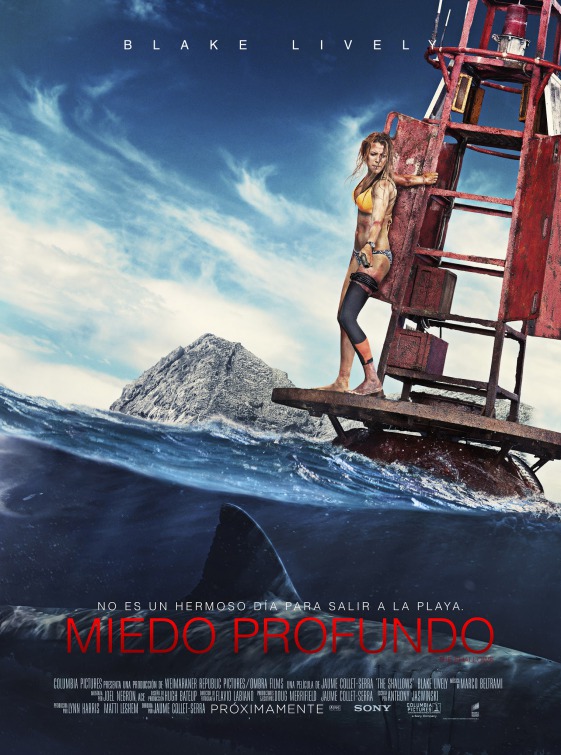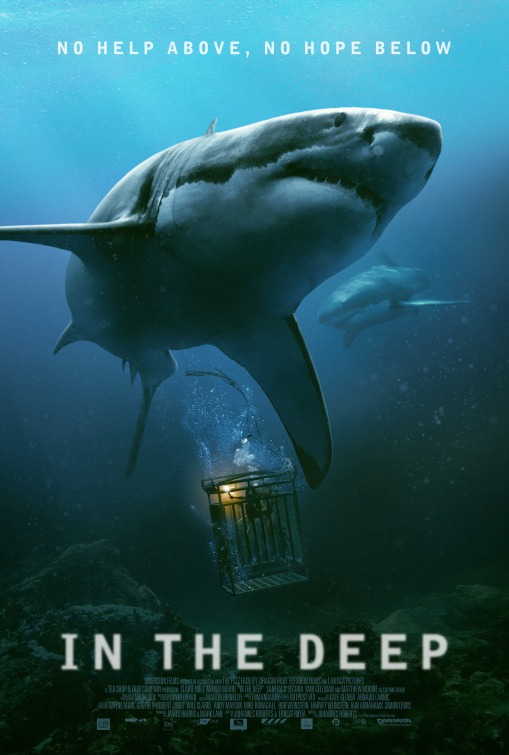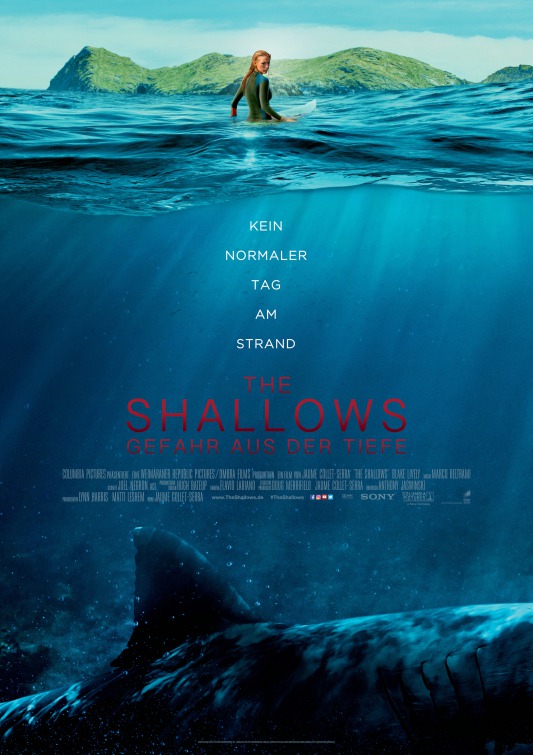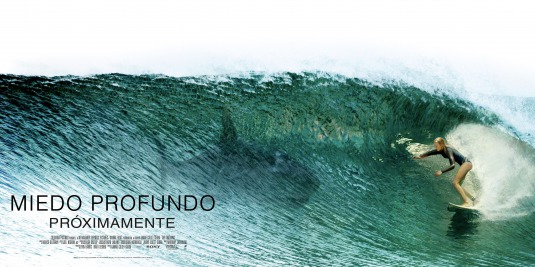
 I'm a sucker for shark films, okay maybe not shark-comedies, chainsaw flying shark-edies and Ghost Shark films. So you know where I'm coming I enjoyed the MEG (novel soon to be a movie) imitators Megalodon (2002) and the more satisfying Shark Hunter (2001) despite their limited production values. Hyped Shark Night failed to beat the better mainstream Deep Blue Sea.
I'm a sucker for shark films, okay maybe not shark-comedies, chainsaw flying shark-edies and Ghost Shark films. So you know where I'm coming I enjoyed the MEG (novel soon to be a movie) imitators Megalodon (2002) and the more satisfying Shark Hunter (2001) despite their limited production values. Hyped Shark Night failed to beat the better mainstream Deep Blue Sea.The versus films for example Mega Shark Versus Crocosaurus, Mega Shark Versus Giant Octopus, Mega Shark Versus Mecha Shark and so on, are all pretty much DVD chum along with Sand Sharks, , Jurassic Shark, Shark Zone, Red Water, Jersey Shore Shark Attack the list goes on and on. There's also the countless Jaws rip off's - The Last Shark, Tintorera, Mako: The Jaws of Death etc.
There's the better ones, Bait and the serious Open Water and The Reef. This is just touching the surface, as you can see there are loads of shark films, many of them just not very good. Then just as you thought it was safe, two entertaining, seriously toned great white films come along, like buses at once. While they may not have the characters of the Moby Dick-like classic Jaws, as well as being well directed and filmatic they have the two ingredients which make them work, great looking great whites and entertaining premises. You have Jaume Collet-Serra's The Shallows with Blake Lively and Johannes Robert's In the Deep with Mandy Moore and Claire Holt both are entertaining in their own right here my low-down on the two.
 ***This review may contain jaw chomping spoilers ***
***This review may contain jaw chomping spoilers ***After the loss of her mother, medical student Nancy Adams travels to a secluded beach. Hitting the waves Nancy finds herself being stalked by a great white shark.
With a broken surf board lying near by a young boy finds a Go-Pro helmet cam and we get to see a recording of how its owner met their demise. We're then introduced to Nancy Adams (Blake Lively) bouncing around in a vehicle in the middle of nowhere, with the feeling we're in a torture tourist film. However, thankfully this is a killer shark film. Interestingly, director Jaume Collet-Serra (Orphan, Unknown) quirkily shows her social media texts and photos as a wipes on screen. Played by Óscar Jaenada , Carlos the broken English local (who does not kill Nancy) drops the surf board touting tourist off safely at the beach. The perfect body, on the perfect beach, with the most perfect waves and scenery sets up a false sense of security.
It's not long before Nancy encounters some surfers who warn her of a strong current and rocks. It not just abs, bikini and cleavage. Surfing film fans may find the first minutes particularly interesting, its wonderfully shot as they surf the waves off the beautiful beach. In addition Collet-Serra makes full use of the unorthodox novel way (breaking the third wall) of the videophone calls and watch face projection on screen. These shots set up the family dynamics, back-story and elapsing time to hold attention and keep momentum. The proceedings are enhanced by Marco Beltrami’s (World War Z, The Thing 2011) score. But this is all inconsequential as deep down you're waiting for the shark to strike.
After a dolphin appears to break things up with a jump scare, Collet-Serra is wise to get to the great white quite quickly with an excellent shot of the sharks silhouette through a huge wave hot on Nancy's heels like something from a Steve Alten novel. When the water turns red - the survival story beings. The Shallows doesn't present great shakes in term of story, it's a basic don't get eaten tale reminiscent of Open Water (2003) and The Reef (2010), person verse nature. The Shallows offers big budget set ups and thrills with a whale carcass and buoy being bashed by the great white, the effects, bruises and bite makeup are finely done, there's also plenty of blood, severed limbs and bites on display. There's a solid performance from Blake Lively who is focal throughout. But the star of the show is the shark, when it breaks the water it's exceptionally realised, it feels and looks for the most part scarily real. This is not a Syfy channel special effect, this great white is unnerving and frightening.
There are calm before the storm moments where Lively's Nancy befriends a seagull, tends to her wounds, talks to herself, the night time shots are particularly eerie as she silently stalked. Inevitably each chance of rescue is thwarted by the tenacious killer. With a handful of shark attacks littered throughout there’s enough moments to maintain interest. Dehydrated, no food and losing blood writer Anthony Jaswinski's offers part an endurance test story as well as a creature feature. As Nancy goes from salvation points, through the salt water, rock to rock, there's plenty of tension as she times her swims in an attempt to out manoeuvre the shark. The slick editing and Jaswinski's story brings the film full circle playing against expectations and with sleight of hand you're into the unknown, with Nancy's fate up for grabs in the closing act where she faces off with the extremely aggressive predator. With high-tides, jelly fish stings, storms closing in, flare guns, Collet-Serra keeps the thrills coming until the end.
Refreshingly it doesn't rehash Jaws. Shark fans will no doubt get an uneasy and unsettled kick out of some of the elaborate stunt setups. With its small cast, excellent lead, beautiful location cinematography, if you’re into stranded shark films you can't go wrong.
Overall, a fast paced, grounded shark attack film and a recommend bite of entertainment.


*** This review contains major spoilers ***
Two women become trapped in a cage 47 meters below the Mexican waters.
It's been a long time since there have been modest budget serious well produced shark films, then in 2016 two come along at once. Thankfully, In the Deep's set up is quite different to The Shallows, but it shares the same high production values and execution. Director Johannes Roberts offers a novel, tense, at times claustrophobic great white film that will leave you gasping for air.
Sisters, one in the mist of a breakup Kate (Claire Holt) and wilder worldly travelled Lisa (Mandy Moore) are restless in the safety of a hotel pool and room in Mexico. Coincidently, Roberts like in The Shallows adopts the film technique of texts, in this case Lisa's ex, popping up on screen, breaking the fourth wall. With Kate being upset the sisters go on a night out and meet two locals, who they later hook up with for a meal and kiss. The next day after a motorboat ride they all go on a $100 each cage dive on a rickety boat, the Sea Esta.
Matthew Modine is the captain of the unofficial excursion and his extended cameo, which is mostly a soothing voice on a radio advising the inexperienced divers on what and what not to do. Modine offers some weight and star power to the film as a everyday sailor Taylor. Like the aforementioned film, it's also different to Jaws, The Reef and the like and stands on its own.
Although, writers Ernest Riera and Roberts sacrifice developing Modine's functional character in place of getting the sharks on screen quicker, they put enough into brunette Moore's self-conscious Lisa and carefree blonde Holt's characters for you to invest their fate. They have an arc from the nightclub holidaymakers to strong women striving to survive. The story is straightforward enough, but visually at times it excels.
When the sea-hand Javier (worthy of note Chris J. Johnson) starts chumming - a shark, approximately 20 foot shows up, bigger than those on the Discovery Channel or in the National Geographic. After the two locals try the first cage as the huge shark circles, the two nervous but excited sisters have their turn with their diving masks and tanks checked. Suffice to say, it all goes wrong when the rusty winch breaks and the the girls descend 47 meters. What follows is a survival test, trapped in the cage at first, then running out of air as they make attempts to move the winch, swim from the bottom ocean floor in the aggressive shark infested waters, to get more air in various ways etc. Only to be thwarted by the finely realised, terrify sharks.
With sharks attacking from nowhere there are some genuine jump scares which are heightened by the sound design and tomanddandy's music. Mark Silk's cinematography really shines, not just on the surface but below water. It's not just the confines of the cage that add chills, it's the vast ocean open space, the silence of being submerged and void beyond the sea cliff's edge. Notable there's a scene with their radio's out of range, Lisa tries to communicate with the surface leaving herself venerable in the endless salt water. Going beyond the sea floor cliffs edge later underwater Kate swims, stopping on top of a protruding rock deep below the blue sea. The unseen giants overshadow each move the women make with the threat of an attack at any moment. Every time the sisters leave the cage you feel the edgy chill of the imposing sharks.
Anyone scared of the water will no doubt get glass-boat diving chills out of In the Deep. And those who love shark films will not be disappointed with the whites on display as they attack, from below and on the sea floor with only cave recesses and the eroding cage to protect the sisters.
Roberts keeps the pressure on as things get worse when a diver is killed and the second attempt to save them goes awry. There's also a fearful doubt throughout that those topside have left them. We get plenty of blood-filled wince moments with the cage crushing Kate, spear gun cuts, shark bites and flares. As they fend off the predators when trying to get air tanks and get to the top it never slows in pace. In addition, Riera and Roberts add an interesting surprise Gravity, Descent-like twist in the tense final act.
Overall, a fine and welcomed addition to the killer Carcharodon carcharias genre.

No comments:
Post a Comment